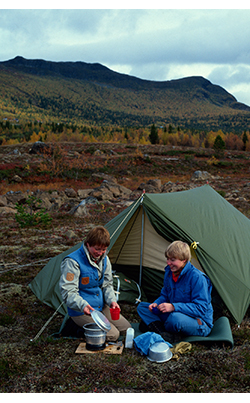History 歷史



The 1964 tent revolution 1964年的帳篷革命

A tent should be easy to carry and pitch, and should offer protection against the weather. Things we take for granted today have not always been so obvious. When Fjällräven launched the first Thermo tent in 1964, it was a sensation that set the standard for how tents should be manufactured, even to this day.
In the early 1960s, most tents were made of a single layer of cotton, and they were heavy. When dry, they weighed around three to four kilos, and when wet, at least double that. The alternative was a synthetic tent. But these were either too thin, allowing the damp to seep through, or so impenetrable that condensation remained on the inside, turning the air inside the tent as moist as in a rainforest.
Double skins for the first thermo tent
Because the founder of Fjällräven, Åke Nordin, neither liked to carry heavy loads nor to wake up in a wet sleeping bag, he decided to try do something about this. Several sketches and prototypes later, Åke had found a solution that was as simple as it was clever: By combining a waterproof flysheet and a breathable inner tent, moisture could be expelled from the living area before condensing on the inner surface of the outer material. Finally, it was possible to wake up warm and dry outdoors.
Straight to Greenland
The first Thermo tent was launched in 1964. The flysheet material comprised a strong, waterproof polyester fabric, while the inner tent was made from thin, breathable "Rutarme" ripstop fabric made from polyamide. At 1.4 kg, the tent is extremely light. The tent was a huge success and was for instance used on the Swedish expedition to Greenland in 1966. One of the expedition participants, Robert af Klinteberg, referred to the excellent qualities of the tents in a telegram: "The first product I"ve come across that is better than advertised".
The thermo tent was the first in a long line of much appreciated models from Fjällräven. To this day, we are still introducing tents which are lauded around the world for being lightweight, user-friendly, solidly built and fitted with smart functions.
一個好的帳篷必須易於攜帶及組裝,也要能抵禦各種天氣變化。我們現在認為理所當然的事物未必向來如此。1964年Fjällräven發表第一款保溫帳篷的時候,就造成一股轟動,為帳篷製作立下新標準,沿用至今。
1960年代早期,大多數的帳篷是由單層棉料製成,十分厚重。乾的時候約三到四公斤,一旦潮濕重量至少加倍。另一種是選用合成布料的帳篷,但這種帳篷不是太薄無法阻絕水氣,就是太不透氣,反而讓裡面的凝水無法排出,搞得帳篷裡的空氣跟雨林一樣潮濕。
首款雙層設計的保溫帳篷
Fjällräven創始人Åke Nordin既不愛背重背囊,也不愛一覺醒來睡在潮濕的睡袋裡,於是又決定解決這個問題。嘗試過無數的草稿和原型之後,他終於找到一種簡單又聰明的解決方案:採用防水外帳篷加透氣內帳篷的方式,水氣會先被排出使用者的活動空間,才凝結在外帳篷的內部表面。如此一來,在戶外也能溫暖乾爽地一覺睡到天亮。
往格林蘭出發
第一款保溫帳篷發表於1964年,外帳篷是強韌防水的聚酯纖維,內帳篷則採用一種由聚醯胺研發出來的Rutarme防撕裂布料,既輕薄又透氣,而且總重量僅有1.4公斤。這款帳篷一出現即大獲好評,馬上被1966年前往格林蘭的瑞典探險隊所採用。其中一名隊員Robert af Klinteberg在電報裡這樣描述這款優質帳篷:「我第一次用到比廣告說的還棒的產品。」
保溫帳篷是個先鋒,之後Fjällräven公司陸續推出了許多為人所推崇的款式。直到現在,我們依然不斷推出全世界稱讚不已的帳篷,每一款都具備輕量、易用、堅固的特性,同時集多種功能於一身。



